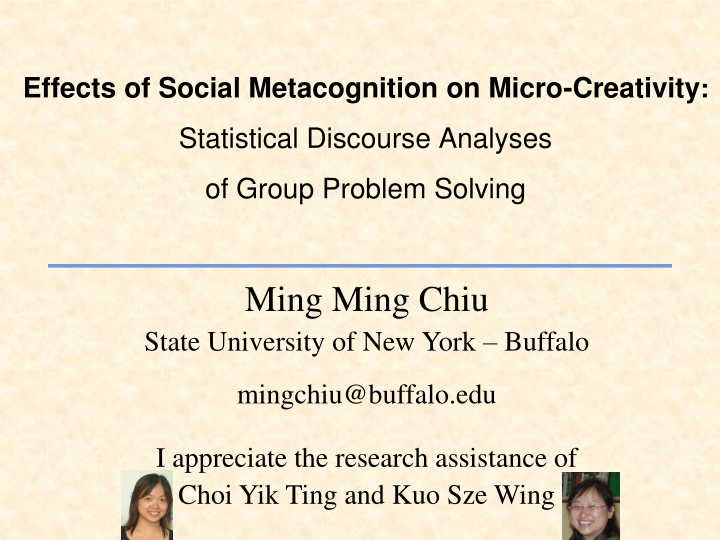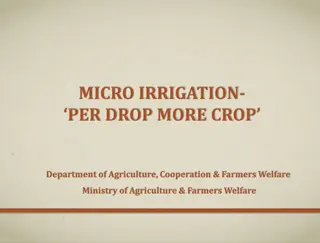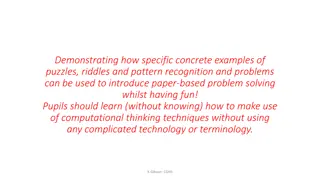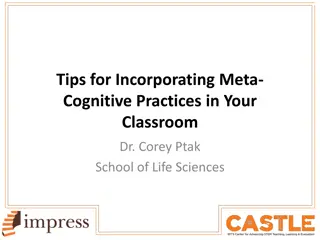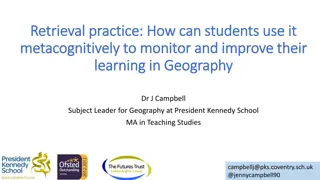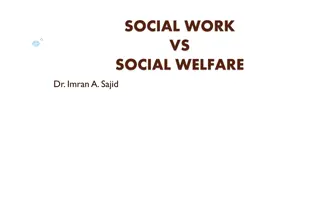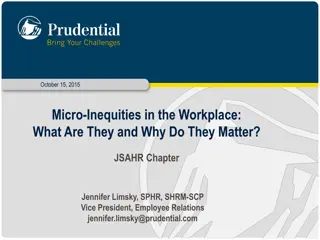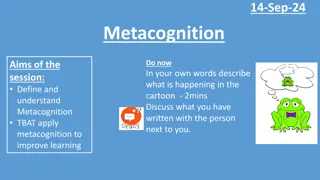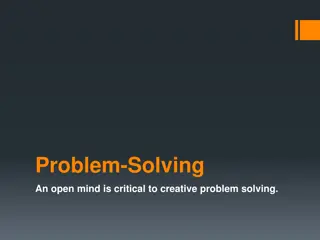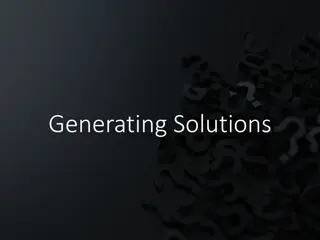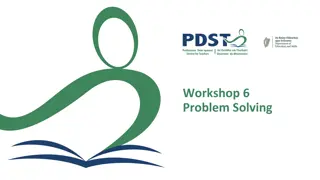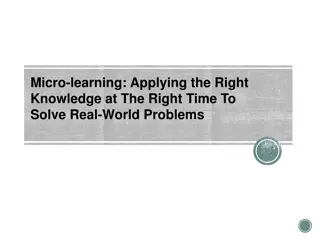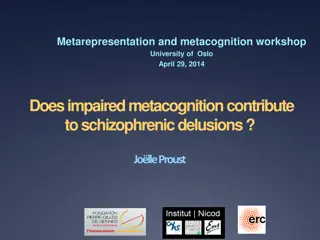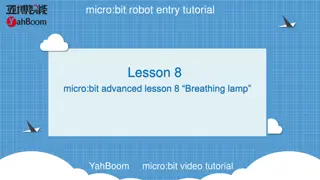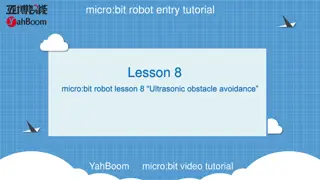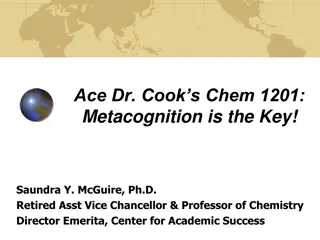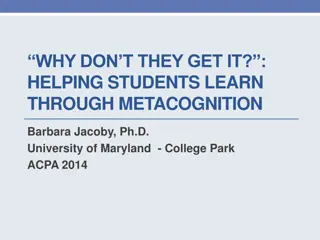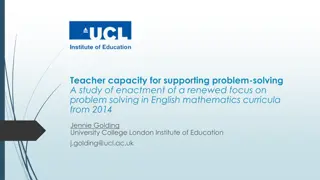Social Metacognition and Micro-Creativity: Group Problem Solving Analysis
This research delves into the impact of social metacognition on micro-creativity during group problem solving. It explores how individuals monitor and control each other's knowledge and actions, leading to the generation of new ideas and justifications. The study emphasizes the significance of social metacognition in fostering creative problem-solving processes.
Download Presentation

Please find below an Image/Link to download the presentation.
The content on the website is provided AS IS for your information and personal use only. It may not be sold, licensed, or shared on other websites without obtaining consent from the author.If you encounter any issues during the download, it is possible that the publisher has removed the file from their server.
You are allowed to download the files provided on this website for personal or commercial use, subject to the condition that they are used lawfully. All files are the property of their respective owners.
The content on the website is provided AS IS for your information and personal use only. It may not be sold, licensed, or shared on other websites without obtaining consent from the author.
E N D
Presentation Transcript
Effects of Social Metacognition on Micro-Creativity: Statistical Discourse Analyses of Group Problem Solving Ming Ming Chiu State University of New York Buffalo mingchiu@buffalo.edu I appreciate the research assistance of Choi Yik Ting and Kuo Sze Wing
Solving problems & Micro-creativity Under the UniversalTexting plan, each text message costs $.10. BudgetTexting costs $.01 per text message, but charges a monthly fee, $18. 1) How many text messages do you send each month? 2) Which company costs less for you? 3) How many texts should you send for the Universal plan and the Budget plan to cost the same?
Solving problems & Micro-creativity Difficult problem for students learning algebra To solve this problem, novice students create new ideasandcheck/justify their utility (micro-creativity processes). More micro-creativity processes Solve problem What group processes micro-creativity processes?
Micro-Creativity Processes Creativity processes Generate ideas Identify/Justify utility ( Sternberg & Lubart, 1999 ) Big C creativity affects society Small c creativity affects person ( Gruber & Wallace, 1999 ) Micro-c creativity processes occur at a moment in time ( Chiu, 2008 )
What Affects Micro-creativity? Social Metacognition? Face / Rudeness?
Social Metacognition Metacognition Monitoring and control of one s knowledge and actions ( Flavell, 1971; Hacker, 1998 ) Social Metacognition Group members monitoring and control of one another s knowledge and actions ( Chiu, in press) Most individuals have poor metacognition. ( Hacker & Bol, 2004 )
Social Metacognition Questions indicate knowledge gaps Identifies gap in someone s understanding Motivates and points out a way to fill the gap to create a new idea (+) Use old or new info to explain/justify (+) (Coleman, 1998; Webb, Troper & Fall, 1995; DeLisi & Goldbeck, 1999 ) Disagree Identify obstacles Overcome via new ideas and/or justifications (+) (Doise, Mugny & Perret-Clermont, 1975; Piaget, 1985)
Face / Rude Disagree Rudely Excessive Agreement Command !
Face / Rude Face = Public Self-image Disagree rudely (attack face) vs. Disagree politely (save face) ( Brown & Levinson, 1987 ) Ten times two hundred. DisagreeRudely No, you re wrong, it s one tenth times two hundred. Previous speaker more likely to retaliate Emotional argument Reduce new ideas & justifications ( ) End cooperation ( Chiu & Khoo, 2003; Gottman & Krokoff, 1989 )
Face / Rude Disagree politely if we want it in dollars, we can multiply two hundred by one tenth. if Hypothetical distances error away No you No direct blame we Shared positioning & common cause Save previous speaker s face Listen & understand obstacle Overcome via new ideas & justifications (+) ( Chiu & Khoo, 2003 )
Face / Rude Agree too much Concern for social relationship Reluctant to disagree with wrong ideas Fewer new ideas & justifications ( ) ( Person, Kreuz, Zwaan, & Graesser, 1995; Tann, 1979; Tudge,1989 )
Face / Rude Command ! Demand implementation of an old idea Suggest that speaker has higher status than audience Ruder than question Threaten face Distract from problem solving Fewer new ideas & justifications ( ) (Brown & Levinson, 1987; Chiu,2008 )
Social Metacognition Ask Questions (+) Disagree (+) Micro-creativity processes New ideas Face / Rudeness Politely Disagree (+) Rudely Disagree ( ) Excessively Agree ( ) Command ( ) Justifications Control variables Math grade Peer Friendship Gender, ethnicity, Group mean grade, Groupgender variance
Videotape Group Problem Solving 84 9th grade, average ability students in US city Work in 21 groups of 4 Not friends Introducing 2 variable algebraic equations 1st day of group work No group work preparation Work on problem for 30 minutes Videotape & Transcripts Two RAs coded each student turn Krippendorf s
Content analysis Jay: A hundred eighty dollars. Ben: If we multiply by ten cents, don t we get a hundred and eighty cents? Ben Disagrees politely New information Correct Justifies Question
Multi-dimensional Coding Evaluation of the previous action Agree ( + ), Neutral ( n ), Ignore/New topic ( * ), Disagree rudely ( ), Disagree politely ( ) Knowledge content regarding problem New idea, Old idea, Null-content ( {} ) Validity Correct ( ), Wrong ( X ), Null-content ( {} ) Justification Justify ( J ), No justification ( [] ), Null-content ( {} ) Invitation to participate Command ( ! ), Question ( ? ), Statement ( _. )
Invitational Form Decision Tree Minimize Number of Coding Decisions to inter-coder reliability Minimize Depth of decision tree Put highly likely actions at the top Do any of the clauses proscribe an action? Yes, code as command (imperative) No, is the subject the addressee? No, are any of the clauses in the form of a question? No, code as statement (declarative) Yes, code as question(interrogative) Yes, is the verb a modal? No, should the described action have been performed, but not done? Yes, code as a command No, code as a question Yes, Is it a Wh- question (who, what, where, why, when, how)? Yes, code as an question No, is the action feasible? Yes, code as a command No, code as an question Based on Labov (2001), Tsui (1992)
Coded Transcript ID Fay Action Do ten times eighteen. EPA KC Valid? Justify IF * C ! Ben Ten times eighteenis + R _. Eva Twenty-eight. + C X _. Jay Wrong. A hundred eighty dollars. C X _. Ben If we multiply by ten cents, don t we get a hundred and eighty cents? Yep. - C J ? Fay + _. Add other variables at each speaker turn: Student: Gender, ethnicity, mid-year algebra grade, Group: Group s mean mid-year algebra grade,
Statistical Discourse Analysis 4 types of Analytical Difficulties Time Outcomes Explanatory variables Data set
Statistical Discourse Analysis Difficulties regarding Time Time periods differ (T2 T4) Strategies Breakpoint analysis Serial correlation (t8 t9)
Identify Breakpoints Breakpoints Critical events radically change interactions Statistically identify breakpoints Test possible combinations of breakpoints Model with smallest Bayesian Info Criterion (BIC) Explain the most variance w/ fewest breakpoints
Breakpoints in 1 group 100% 80% % New ideas % Micro-creativity 60% 40% 20% 0% 0 10 20 30 Time (mins)
Statistical Discourse Analysis Difficulties regarding Time Time periods differ (T2 T4) Strategies Breakpoint analysis Multilevel analysis (MLn, HLM) Serial correlation (t8 t9) Test with Q-statistics Model with lag outcomes e.g. Justify (-1)
Statistical Discourse Analysis Outcome Difficulties Strategies Discrete outcomes (Yes / No) Logit / Probit Multiple outcomes (Y1, Y2) New idea & Justify Multivariate, multilevel analysis
Statistical Discourse Analysis Explanatory model Difficulties People & Groups differ Mediation effects (X M Y) False positives (+ + + +) Effect across turns (X6 Y9)
Effects across several turns 2 speakers ago = ( 2) Ben: 10 times 18 is Eva: 28. 1 speaker ago = ( 1) Jay: Wrong, 180 dollars.
Statistical Discourse Analysis Explanatory model Difficulties Strategies People & Groups differ Multilevel cross-classification Multilevel mediation tests Mediation effects (X M Y) 2-stage linear step-up procedure False positives (+ + + +) Vector Auto-Regression (VAR) Lag explanatory variables e.g., Disagree (-1), Girl (-1) Disagree (-2) Effect across turns (X6 Y9)
VAR models effects across turns Action Fay Do ten times eighteen. ID Justify 0 Disagree 0 Disagree (-1) - Ben Ten times eighteenis 0 0 0 Eva Twenty-eight. 0 0 0 Jay Wrong. A hundred eighty dollars. If we multiply by ten cents, don t we get a hundred and eighty cents? Yep. 0 1 0 Ben 1 1 1 Fay 0 0 1
Statistical Discourse Analysis Data Difficulties Strategies Missing data (101?001?10) Markov Chain Monte Carlo multiple imputation Separate outcome models Robustness Use data subsets Use unimputed data
Results: Breakpoints 2.65 new idea breakpoints per group 3.65 time periods per group (min=1; max =6) 2.05 justification breakpoints per group 3.05 time periods per group (min=1; max =6) Number of breakpoints did not differ across groups that solved vs. did not solve the problem
3 Types of Breakpoints Creativity process generators Sharply increase new ideas or justifications Creativity process dampeners Sharply decrease new ideas or justifications On-task Off-task transitions
Creativity generator Ana Bob Cate Dan Cate Dan Ana How can they be equal? I don t know Try another number? Which number? [8 seconds of silence; each student looks at own paper] [looks at Ana s paper] Yours is much closer. So, try a number close to yours [looks at Ana s paper] Mine s even closer [looks at Dan s paper] Oh! More messages get us closer
Creativity dampener Kay Let s try a hundred. Lee Ok. That s a thousand. Tom And that s one, so nineteen. Kay That s like over nine hundred away. Jan Maybe it s one of those trick questions. Tom Yeah, like it can t be done. Kay So, maybe there s no answer. Lee Then, we re done.
Explanatory model: New Idea & Justify Previous turn (-1) Current turn Outcomes Rudely Disagree New Idea Rudely Disagree (-1) Agree Rudely Disagree (-1) * Unsolved Rudely Disagree (-1) *Wrong (-2) Peer Friendship Command (-1) Justify Politely Disagree Math grade (-1) Math grade (-1) *Unsolved
Group + Time Period Differences Unsuccessful groups: Negative effect of Rudely disagree (-1) on new ideas Negative effect of Math grade (-1) on justifications Mathematics grade s effect on justifications Differed across both time periods and across groups -2% to +1% in unsuccessful groups -1% to +3% in successful groups
Unsupported Hypotheses Questions were not linked to New idea or Justifications Rudely disagreements were not linked to Justifications
Implications for Teachers & Students Increase Group Micro-creativity Ask questions rather than issue commands ! Disagree politely to encourage justifications Listen to rude disagreements and use the content to develop new ideas
Implications for Researchers Statistically identify critical moments (breakpoints) that radically change subsequent processes Effects differ across groups, time periods, turns Use statistical model to compute specific effect Effects of sequences Look beyond the effects of single actions New method for statistically modeling conversations
Further applications What major or momentary events affect people s behaviors over time during Classroom conversations? Online discussions? A student s think-aloud problem solving? An infant s learning of a new word? Basketball games? Stock market transactions? Wars?
Previous Turn 1 2 3 Valid (-1) X X ID Ana Do three times four. Ben Three times four is seven Eva Three times four is nine. Jay Three times four is twelve. Action Turn # Valid? 1 2 3 4 X X Respond to turn #? 1 1 3 Valid (-1) X ID Ana Do three times four. Ben Three times four is seven Eva Three times four is nine. Jay Three times four is twelve. Action Turn # Valid? 1 2 3 4 X X
Statistical Discourse Analysis Analytical Difficulty Differences across topics Time periods differ (T2 T4) Serial correlation (t8 t9) Parallel talk ( ) Store path: ID prior turn, Vector Auto-Regression Strategy Multilevel analysis Breakpoint analysis & Multilevel analysis I2 index of Q-statistics; Model with lag variables Discrete outcomes (Yes / No) Multiple outcomes (Y1, Y2) Infrequent outcomes (00010) Logit / Probit Multivariate outcome models Logit bias estimator People & Groups differ Mediation effects (X M Y) False positives (+ + + +) Missing data (101?001?10) Robustness Multilevel analysis Multilevel mediation tests 2-stage linear step-up procedure Markov Chain Monte Carlo multiple imputation Separate outcome models; Data subsets & unimputed data
Knowledge content, Validity, and Justification Does the speaker express any mathematics or problem- related information? No, code as null content Yes, is all the info on the group's log/trace of problem solving? Yes, code as repetition No, code as contribution and write specific info in group's log Does this info violate any mathematics or problem constraints? Yes, code as incorrect No, code as correct Does the speaker justify his or her idea? Yes, code as justification No, code as no justification
Mathematics Bayesian Information Criterion 2 ln( ) L k n + n n Regression specification ijk = F( 0 + f0jk+ g00k+ 00sS00k + 00tT00k+ ujkUijk + vjkV(i-1)jk + vjkV(i-2)jk + vjkV(i-3)jk + vjkV(i-4)jk)
